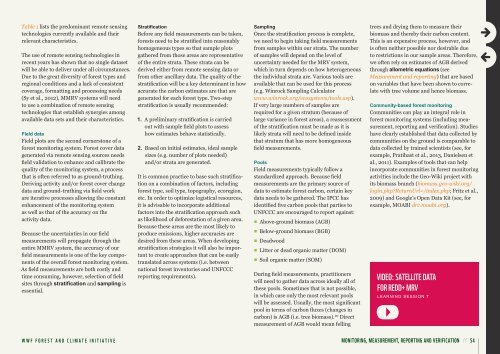WWF Guide to Building REDD+ Strategies
WWF Guide to Building REDD+ Strategies
WWF Guide to Building REDD+ Strategies
Create successful ePaper yourself
Turn your PDF publications into a flip-book with our unique Google optimized e-Paper software.
Table 1 lists the predominant remote sensing<br />
technologies currently available and their<br />
relevant characteristics.<br />
The use of remote sensing technologies in<br />
recent years has shown that no single dataset<br />
will be able <strong>to</strong> deliver under all circumstances.<br />
Due <strong>to</strong> the great diversity of forest types and<br />
regional conditions and a lack of consistent<br />
coverage, formatting and processing needs<br />
(Sy et al., 2012), MMRV systems will need<br />
<strong>to</strong> use a combination of remote sensing<br />
technologies that establish synergies among<br />
available data sets and their characteristics.<br />
Field data<br />
Field plots are the second corners<strong>to</strong>ne of a<br />
forest moni<strong>to</strong>ring system. Forest cover data<br />
generated via remote sensing sources needs<br />
field validation <strong>to</strong> enhance and calibrate the<br />
quality of the moni<strong>to</strong>ring system, a process<br />
that is often referred <strong>to</strong> as ground-truthing.<br />
Deriving activity and/or forest cover change<br />
data and ground-truthing via field work<br />
are iterative processes allowing the constant<br />
enhancement of the moni<strong>to</strong>ring system<br />
as well as that of the accuracy on the<br />
activity data.<br />
Because the uncertainties in our field<br />
measurements will propagate through the<br />
entire MMRV system, the accuracy of our<br />
field measurements is one of the key components<br />
of the overall forest moni<strong>to</strong>ring system.<br />
As field measurements are both costly and<br />
time consuming, however, selection of field<br />
sites through stratification and sampling is<br />
essential.<br />
Stratification<br />
Before any field measurements can be taken,<br />
forests need <strong>to</strong> be stratified in<strong>to</strong> reasonably<br />
homogeneous types so that sample plots<br />
gathered from those areas are representative<br />
of the entire strata. These strata can be<br />
derived either from remote sensing data or<br />
from other ancillary data. The quality of the<br />
stratification will be a key determinant in how<br />
accurate the carbon estimates are that are<br />
generated for each forest type. Two-step<br />
stratification is usually recommended:<br />
1. A preliminary stratification is carried<br />
out with sample field plots <strong>to</strong> assess<br />
how estimates behave statistically.<br />
2. Based on initial estimates, ideal sample<br />
sizes (e.g. number of plots needed)<br />
and/or strata are generated.<br />
It is common practice <strong>to</strong> base such stratification<br />
on a combination of fac<strong>to</strong>rs, including<br />
forest type, soil type, <strong>to</strong>pography, ecoregion,<br />
etc. In order <strong>to</strong> optimize logistical resources,<br />
it is advisable <strong>to</strong> incorporate additional<br />
fac<strong>to</strong>rs in<strong>to</strong> the stratification approach such<br />
as likelihood of deforestation of a given area.<br />
Because these areas are the most likely <strong>to</strong><br />
produce emissions, higher accuracies are<br />
desired from these areas. When developing<br />
stratification strategies it will also be important<br />
<strong>to</strong> create approaches that can be easily<br />
translated across systems (i.e. between<br />
national forest inven<strong>to</strong>ries and UNFCCC<br />
reporting requirements).<br />
Sampling<br />
Once the stratification process is complete,<br />
we need <strong>to</strong> begin taking field measurements<br />
from samples within our strata. The number<br />
of samples will depend on the level of<br />
uncertainty needed for the MRV system,<br />
which in turn depends on how heterogeneous<br />
the individual strata are. Various <strong>to</strong>ols are<br />
available that can be used for this process<br />
(e.g. Winrock Sampling Calcula<strong>to</strong>r<br />
www.winrock.org/ecosystems/<strong>to</strong>ols.asp).<br />
If very large numbers of samples are<br />
required for a given stratum (because of<br />
large variance in forest areas), a reassessment<br />
of the stratification must be made as it is<br />
likely strata will need <strong>to</strong> be defined inside<br />
that stratum that has more homogeneous<br />
field measurements.<br />
Pools<br />
Field measurements typically follow a<br />
standardized approach. Because field<br />
measurements are the primary source of<br />
data <strong>to</strong> estimate forest carbon, certain key<br />
data needs <strong>to</strong> be gathered. The IPCC has<br />
identified five carbon pools that parties <strong>to</strong><br />
UNFCCC are encouraged <strong>to</strong> report against:<br />
n Above-ground biomass (AGB)<br />
n Below-ground biomass (BGB)<br />
n Deadwood<br />
n Litter or dead organic matter (DOM)<br />
n Soil organic matter (SOM)<br />
During field measurements, practitioners<br />
will need <strong>to</strong> gather data across ideally all of<br />
these pools. Sometimes that is not possible,<br />
in which case only the most relevant pools<br />
will be assessed. Usually, the most significant<br />
pool in terms of carbon fluxes (changes in<br />
carbon) is AGB (i.e. tree biomass). 10 Direct<br />
measurement of AGB would mean felling<br />
trees and drying them <strong>to</strong> measure their<br />
biomass and thereby their carbon content.<br />
This is an expensive process, however, and<br />
is often neither possible nor desirable due<br />
<strong>to</strong> restrictions in our sample areas. Therefore,<br />
we often rely on estimates of AGB derived<br />
through allometric equations (see<br />
Measurement and reporting) that are based<br />
on variables that have been shown <strong>to</strong> correlate<br />
with tree volume and hence biomass.<br />
Community-based forest moni<strong>to</strong>ring<br />
Communities can play an integral role in<br />
forest moni<strong>to</strong>ring systems (including measurement,<br />
reporting and verification). Studies<br />
have clearly established that data collected by<br />
communities on the ground is comparable <strong>to</strong><br />
data collected by trained scientists (see, for<br />
example, Pratihast et al., 2013, Danielsen et<br />
al., 2011). Examples of <strong>to</strong>ols that can help<br />
incorporate communities in forest moni<strong>to</strong>ring<br />
activities include the Geo-Wiki project with<br />
its biomass branch (biomass.geo-wiki.org/<br />
login.php?ReturnUrl=/index.php; Fritz et al.,<br />
2009) and Google’s Open Data Kit (see, for<br />
example, MOABI drc.moabi.org).<br />
video: Satellite data<br />
FoR Redd+ mRv<br />
LEARNING SESSION 7<br />
<strong>WWF</strong> FOREST AND CLIMATE INITIATIVE moni<strong>to</strong>RinG, meaSuRement, RePoRtinG and veRiFiCation // 54

















